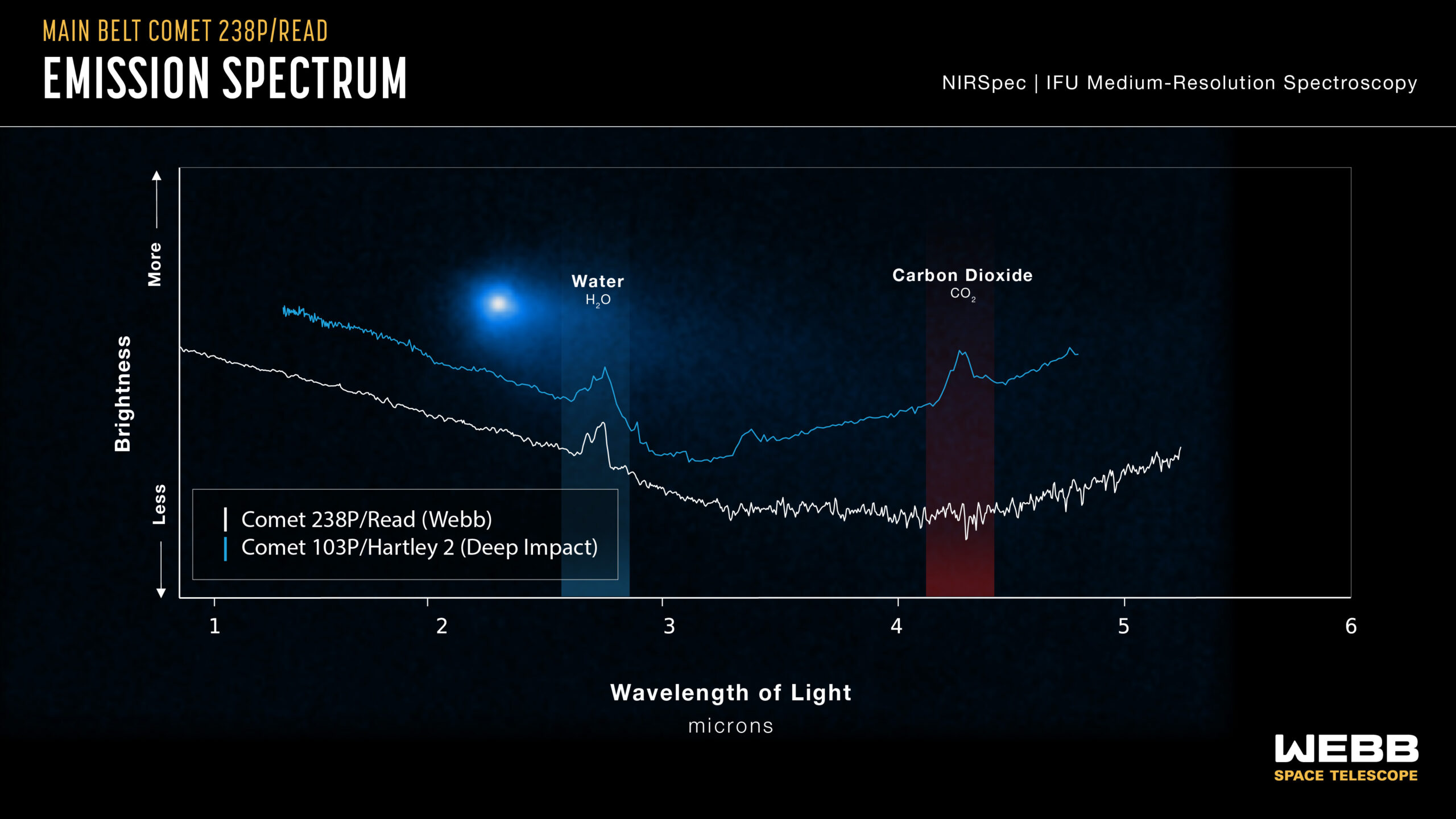Insider Brief:
- NASA’s James Webb Space Telescope’s NIRSpec (Near-Infrared Spectrograph) instrument, astronomers have confirmed gas – specifically water vapor – around a comet in the main asteroid belt for the first time.
- The successful detection of water comes with a new puzzle: unlike other comets, Comet 238P/Read had no detectable carbon dioxide.
- The next step is taking the research beyond Comet Read to see how other main belt comets compare.
NEWS RELEASE — May 15, 2023 — NASA’s James Webb Space Telescope has enabled another long-sought scientific breakthrough, this time for solar system scientists studying the origins of Earth’s abundant water. Using Webb’s NIRSpec (Near-Infrared Spectrograph) instrument, astronomers have confirmed gas – specifically water vapor – around a comet in the main asteroid belt for the first time, indicating that water ice from the primordial solar system can be preserved in that region. However, the successful detection of water comes with a new puzzle: unlike other comets, Comet 238P/Read had no detectable carbon dioxide.
“Our water-soaked world, teeming with life and unique in the universe as far as we know, is something of a mystery – we’re not sure how all this water got here,” said Stefanie Milam, Webb deputy project scientist for planetary science and a co-author on the study reporting the finding. “Understanding the history of water distribution in the solar system will help us to understand other planetary systems, and if they could be on their way to hosting an Earth-like planet,” she added.
Comet Read is a main belt comet – an object that resides in the main asteroid belt but which periodically displays a halo, or coma, and tail like a comet. Main belt comets themselves are a fairly new classification, and Comet Read was one of the original three comets used to establish the category. Before that, comets were understood to reside in the Kuiper Belt and Oort Cloud, beyond the orbit of Neptune, where their ices could be preserved farther from the Sun. Frozen material that vaporizes as they approach the Sun is what gives comets their distinctive coma and streaming tail, differentiating them from asteroids. Scientists have long speculated that water ice could be preserved in the warmer asteroid belt, inside the orbit of Jupiter, but definitive proof was elusive – until Webb.
“In the past, we’ve seen objects in the main belt with all the characteristics of comets, but only with this precise spectral data from Webb can we say yes, it’s definitely water ice that is creating that effect,” explained astronomer Michael Kelley of the University of Maryland, lead author of the study.
“With Webb’s observations of Comet Read, we can now demonstrate that water ice from the early solar system can be preserved in the asteroid belt,” Kelley said.
The missing carbon dioxide was a bigger surprise. Typically, carbon dioxide makes up about 10 percent of the volatile material in a comet that can be easily vaporized by the Sun’s heat. The science team presents two possible explanations for the lack of carbon dioxide. One possibility is that Comet Read had carbon dioxide when it formed but has lost that because of warm temperatures.
“Being in the asteroid belt for a long time could do it – carbon dioxide vaporizes more easily than water ice, and could percolate out over billions of years,” Kelley said. Alternatively, he said, Comet Read may have formed in a particularly warm pocket of the solar system, where no carbon dioxide was available.
The next step is taking the research beyond Comet Read to see how other main belt comets compare, says astronomer Heidi Hammel of the Association of Universities for Research in Astronomy (AURA), lead for Webb’s Guaranteed Time Observations for solar system objects and co-author of the study. “These objects in the asteroid belt are small and faint, and with Webb we can finally see what is going on with them and draw some conclusions. Do other main belt comets also lack carbon dioxide? Either way it will be exciting to find out,” Hammel said.
Co-author Milam imagines the possibilities of bringing the research even closer to home.
“Now that Webb has confirmed there is water preserved as close as the asteroid belt, it would be fascinating to follow up on this discovery with a sample collection mission, and learn what else the main belt comets can tell us.”
The study is published in the journal Nature.
The James Webb Space Telescope is the world’s premier space science observatory. Webb will solve mysteries in our solar system, look beyond to distant worlds around other stars, and probe the mysterious structures and origins of our universe and our place in it. Webb is an international program led by NASA with its partners, ESA (European Space Agency) and the Canadian Space Agency.
Contact Information:
Laura Betz
NASA’s Goddard Space Flight Center, Greenbelt, Md.
[email protected]
Leah Ramsay / Christine Pulliam
Space Telescope Science Institute, Baltimore, Md.
[email protected] / [email protected]
SOURCE: NASA
Featured image: Graphic presentation of spectral data highlighting a key similarity and difference between observations of Comet 238P/Read by the NIRSpec (Near-Infrared Spectrograph) instrument on NASA’s James Webb Space Telescope in 2022 and observations of Comet 103P/Hartley 2 by NASA’s Deep Impact mission in 2010. Credit: NASA, ESA, CSA, and J. Olmsted (STScI)
If you found this article to be informative, you can explore more current space industry news, exclusives, interviews, and podcasts.
Share this article:










